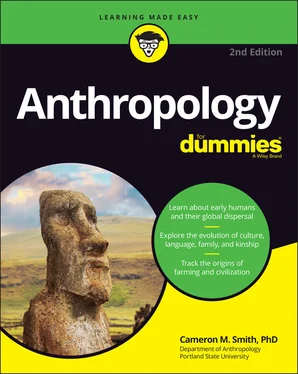One thing that makes physical anthropology particularly complex is that humanity evolves not only as a result of biological factors but also because of cultural factors. For this reason, anthropologists call it biocultural evolution. Culture — which I discuss more thoroughly in Chapters 2and 11— is basically the set of ideas that condition how you see and act in the world. Although humans survive by using both their biology and cultural information, all other animals survive mainly through their biology and by relying on instinct rather than such cultural information.
For example, cultural, not instinctual, information would have instructed you (if you were an early human) that certain kinds of wood are better than others for making a digging stick. You wouldn’t have known about different kinds of wood instinctually, but because detailed information about the properties of different kinds of wood was passed on to your mind culturally — through some form of language — by your parent generation or your siblings or others in your group.
IS THE HUMAN SPECIES STILL EVOLVING?
One of the most common questions asked of anthropologists is whether the human species is still evolving. Have we reached a pinnacle? Will we become giant-brained, fragile-bodied space-dwellers, using only a single finger to press buttons in the far future?
The simple answer is that yes, we’re still evolving; if we have offspring (replicate), if those offspring aren’t clones (variation), and if not all of our offspring survive to sexual maturity (selection), then by definition, the human species is evolving. But it’s natural to ask whether we’re still evolving because — in developed countries at least — humanity has used medicine and other means to eliminate a lot of the pressures that once took so many of our children. With so many selective pressures defeated (at least in the short term), you may easily conclude that significant genetic evolution has stalled in developed countries in the last century or so. Well, this is somewhat the case, although we continue to change genetically over time. But there is another way that we’re evolving, and its evolution is very rapid.
This other “channel” of our evolution is human culture, and this process is just as important as human genetic evolution. Human culture can change very rapidly, and the changes affect millions. Whereas we’ve had about the same size and shape of skull for 100,000 years, imagine the differences between the United States (say, in clothing and musical styles, concepts of race and religion, and the ethnic diversity of the population) in 1950 and the United States in 2020 — some pretty major changes occurred in the late 1960s (for example, the success of the civil rights movement), and in the past two decades we have had huge transformations in how we access information and interact socially. Whether the changes are good or bad is another matter; for the moment, the important idea is that yes, humanity is still evolving in a very significant way, sometimes very quickly.
This difference may seem trivial, but it’s actually very important. For example, consider the following cultural behaviors and their possible involvement with biological evolution of our species:
The earliest use of stone tools corresponds with increased consumption of animal tissues (for example, meat and organs). More animal tissue in the diet was only available by the use of stone tools, which were complex enough that young hominins would have to be taught a lot about them; that is the use of an increasingly complex culture to survive.
The use of clothing (itself a cultural artifact) allows human bodies to survive in environments they wouldn’t normally survive in. For example, the human body is naturally best-suited for equatorial environments, not the Arctic, but the invention of heavy coats and other such clothing enables that body to survive Arctic temperatures.
Paleoanthropologists are deeply concerned with understanding how cultural, noncultural, and biocultural evolutionary factors shaped humanity through time.
Considering that analyzing and understanding a single fossil skull can take years (in addition to what may have been an extensive search and excavation), it’s no surprise that paleoanthropology requires a lot of patience. The fossil hunters can seem a little whacky when they announce new discoveries … but you should perhaps give them a little slack. It’s a slow business… .
Archaeology: The Study of Ancient Societies
Archaeology studies ancient societies through their material remains, which you may know as artifacts. These artifacts number in the billions and pepper the globe, each a piece to the puzzle of our ancestors’ lives. Every arrowhead, every stone net-weight, every clay pipe-stem and shard of glass, every mud brick and gnawed bone and corroding sword have something to tell about the lives of past human societies, and the archaeologists’ job is to fit the puzzle back together.
Fitting the puzzle back together is a great challenge. Archaeology isn’t that technically difficult or even expensive (compared, to, say, nuclear physics or chemistry), but it takes a long time to do well. Because artifacts are so numerous, and archaeologists are eager to extract as much information from each object as possible, excavations of archaeological sites can take years, even generations.
Archaeological research has many goals but normally adheres to some common principles:
Establishing chronologies, or sequences of events in the ancient world, such as dating when things first happened (for example, the use of writing, farming, or fire)
Establishing a spatial understanding of the chronicled events, such as where the first writing, farming, or use of the wheel occurred, and what that can reveal about their invention
Understanding the evolution of ancient cultures through time so as to better understand why certain societies survived and others collapsed, or answer other large questions, such as what prompted the change from small-scale chiefdoms to large-scale civilizations
Archaeologists establish chronologies by carefully noting the age of artifacts recovered in excavations. They must carry excavations out carefully so they can record the exact position of artifacts; this care is critical to understanding the artifacts’ ages for many reasons (which you can read more about in Chapter 5).
Carefully recording where artifacts are found is another way to achieve spatial understanding. If a stone bowl came from a cave in southern Mexico, you don’t want to confuse it with one found in northern Peru (they’re both from the Western Hemisphere, but they were made by quite different cultures). This obvious logic extends all the way down to the centimeter, such that archaeologists work long hours carefully recovering artifacts with whisk brooms and other delicate instruments.
Archaeology and evolution
Evolution is characterized by change; so, to understand ancient cultural evolution, archaeologists often focus on what changed through time in the ancient society they’re investigating.
For example, around 10,000 years ago people in the Danube River valley of southeastern Europe were highly mobile foragers (hunter-gatherers) who left only short-lived campsites for archaeologists to discover. But by about 7,500 years ago, they were a rather sedentary people, living for generations at a time in riverside villages that you would normally associate with farming people. However, the folk of these villages, including the fascinating site of Lepenski Vir, weren’t full-time farmers; they continued to hunt and gather. Something, then, changed in their culture, and archaeologists want to know what it was.
Читать дальше












